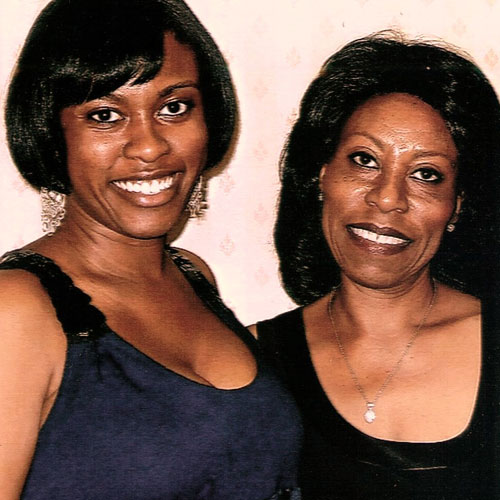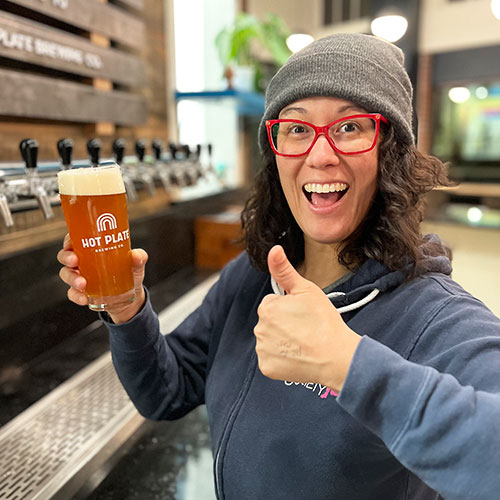Imagine a backyard barbeque in Northern California in the 1990s. Kids in sun-worn fluorescent bathing suits cannonball into the deep end of the pool. Adults grill hot dogs and chat. A woman sits in a flimsy, plastic chair, her curly, jet-black hair surrounding her head like a halo. When she opens her mouth to laugh, red lipstick yields to an orange-slice smile with a charming front-tooth gap. She’s got a cigarette in one hand and a Sierra Nevada Pale Ale in the other, nestled inside a chunky foam koozie. That’s my mom, and the bright green of that label of my youth stays with me today.
But Sierra Nevada Pale Ale wasn’t my beer of origin. I was too young still, searching for sunken pool toys in the shallow end. Years later, Mom swapped the brown bottle for one from a new local craft brewery: Lagunitas IPA. The town of Lagunitas was a place my dad took us to walk amongst tall trees, teaching us about fungus and flowers. The actual brewery in Petaluma was a short drive up the highway. I fell in love with that beer. I tried to steal it for high school parties—my mom was madder about her beer being taken than about me taking beer.
Invitation Lost in the Male
When I think of my beer origin story, I always see a vision of my mom in her late 30s. I soon learned that this association is rare. According to research by the Brewers Association, craft drinkers were 31.5 percent female and 68.5 percent male in 2018, shifting from 29.1 percent female in 2015.
It’s no surprise that beer has been perpetuated as a man’s drink. In Beer and Society: How We Make Beer and Beer Makes Us, authors Eli Revelle Yano Wilson and Asa B. Stone point out that “gendered framing of beer consumption” has a strong history in magazine ads, TV commercials, billboards, etc. To take this point further, Tara Nurin’s A Woman’s Place Is in the Brewhouse spends an entire chapter revisiting sexist advertising paid for by the beer industry.
When you’re not exposed to something or you don’t feel represented as part of the group (worse, if you’re the brunt of the joke), you’re less likely to try that thing. Thus, the ones who pioneered craft beer were “educated, cisgender heterosexual (cishet), white men categorically,” according to Beer and Society. Almost half a century later, less than 2% of breweries are solely owned by women, according to the Brewers Association.
We’ve heard the stories of dads getting their daughters into beer—and Nurin devotes an entire chapter to this, too—but rarely do we hear about the moms who influenced us. I couldn’t be the only one. Yet when I asked women in the beer industry “Did your mom get you into beer?” most didn’t say yes explicitly.
The Implicit Value of Beer-Drinking Mothers

A handful of answers echoed Whitney Froelich’s, who is in marketing and an assistant brewer at Cocoon Brewing in De Pere, Wis.
“Quite the opposite,” she replies. “My mom has only ever drunk Miller Lite, which I can’t stand. I thought that’s what all beer tasted like until I was maybe 28!” She calls herself a late bloomer.
“Context matters,” Stone and Wilson write in Beer and Society. “…our social environment structures the personal relationships we have with beer—and each other.” If mass-produced big beer is what’s in your household growing up, then that’s the definition of beer to you until new information comes along to widen that perspective.
“I didn’t realize beer wasn’t considered a ‘woman’s drink’ until I started drinking craft beer,” says food and beverage content creator Stephanie Grant. You read that right: Grant’s introduction to craft beer led to her noticing the disparity. At home, her parents were supposed to share six-packs equally—a rule her mother stuck to diligently and her father broke sometimes with giddy excitement, which the kids found entertaining.
Now, Grant admits she may have turned into her mother. “If my husband happens to drink a beer I have my eyes on, hell will be raised until laughter takes over,” she says.

Grant’s story is a tender reflection of what Stone and Wilson state in their book, “…our relationships with beer are deeply sociological and psychological; our drinking practices are not entirely our own.”
Here, Grant goes deeper: “Without knowing, my mom told me beer was for everyone who wanted to drink it. Gender didn’t matter. Race didn’t matter. The only thing that did matter was making sure you left enough beer for everyone else to enjoy.”
Craft or not, our beer-drinking moms showed us from day one that beer isn’t just a man’s drink.
Women and Beer Come Full Circle
Upon further investigation, you’ll find that beer didn’t even start off in the hands of men.
Brewing is cooking, so it’s no wonder that beer was brewed by women who also baked and took care of the home while men were out hunting or tending to farms. Gregg Smith, author of Beer in America, is often quoted as saying, “When money got involved, men increasingly started brewing.”
Although “millions upon millions of women throughout history have cooked this critical liquid,” writes Nurin in A Woman’s Place, it’s rare to find someone like Guinevere Bell, co-owner of Traust Brewing Company in Mount Holly, N.C., who grew up with a homebrewing mother.
“I remember the smells of brewing vividly,” Bell reminisces, who says her mom also collected “special beers like Sierra Nevada Celebration ale.” Naturally, Bell grew up a craft beer fan, but “never saw it as a profession [for herself] until Covid.” Something about a global pandemic allowed Bell to kick convention in the teeth and open a brewery. Now, the smell of brew days offers her sweet nostalgia.
Kindsey Bernhard, director of hospitality and general manager at Austin Beerworks, also grew up with a beer-drinking mother who had started bringing home more interesting beers than the basic domestic choices during the craft beer boom of the early 2000s. Bernhard was avoidant at first, having been utterly disgusted by an IPA her mother encouraged her to try.
Finally, Bernhard’s “aha” moment came on a trip to New Orleans for her 21st birthday with her mom. Again, at her mother’s request for her to try something other than the macro brands, Bernhard obliged and ordered NOLA Brewing’s Blonde Ale. Her world was changed.
“I’ve been working in the beer industry since the age of 22 and I credit my love of this industry to my mom. Without her, I would have never been introduced to beer and a career I love,” Bernhard says. “A lot of people aren’t that lucky.”
Intricacies, Nuances, and Cultural Implications
“Beer is a cultural object we collectively invest with meaning,” Stone and Wilson write. Culture, whether centuries-old tradition or simply actions established by our parents, creates the foundation for our individual relationships with beer.
Like Bernhard, Krista Orzel, wholesale account manager at JAFB Wooster Brewery in Wooster, Ohio, readily gives her mother credit for her relationship with beer today.
“With German roots, my mom has always shared her love for dunkels—points if served with German chocolate cake,” Orzel says. Oktoberfests and meals with friends and family at the local German restaurant were integral to her upbringing.
“In our family, beer has always been included in celebrations. It is a huge part of what ties me to my family history, and I am grateful for that every day.”

However, countless folks are raised without models for moderate drinking. Upon first reaction to my question about moms influencing us with beer, Sarah Real, owner and brewster of Hot Plate Brewing Company in Pittsfield, Mass., thought “no way.” Sarah’s mom, who doesn’t drink, had an abusive alcoholic father, and Sarah’s dad (now divorced from her mother) is a recovering alcoholic.
“So there’s quite a bit of weight around the topic of alcohol” in their family, Real says. “Needless to say, I wasn’t exposed to social drinking, just drinking or nothing at all.”
Despite this, Real knew she wanted to become a brewer straight out of college, and her mom responded with something to the effect of “Isn’t that for guys?” Real was beside herself. (Her mother’s reaction illuminates the importance of research like that in Beer and Society and A Women’s Place Is in the Brewhouse).
Real’s flame intensified. “I silently fumed,” she says. “That comment stuck with me. I decided that I wanted to see myself in the brewhouse and changed my life to do it.”
She knows she’s “not the only one who has struggled with a parent questioning the passion” around beer or other fermented beverages. Thanks to Real’s fierce independence and questioning of sociological patterns, she’s one more woman in the brewhouse and one more female owner.
People like Real are how industries evolve. “Changes start with representation and imagery,” Stone and Wilson write. “People need to be able to see people like themselves engaging positively with beer and within brewery spaces.” Because of Real’s tenacity, even her mom has come around to enjoy the magic of craft beer, which is the ultimate cherry on top.
The Beer Butterfly Effect
In A Woman’s Place Is in the Brewhouse, Nurin writes that she loves “the idea of brewers teaching their young kids, especially daughters, to brew when time allows. Not only does it give children a respect for alcohol and responsible consumption, it gives them hands-on ways to learn and apply math and science.”
My mom wasn’t a brewer and I wasn’t very good at math or science as a kid. As an adult, now that math equals money and science equals food and drinks, I’m getting better at both. Beer had a leading role in this transformation.
I’m sure my mom’s hankering for craft beer paved the way for me to explore different parts of my brain as well as inherently push back against social norms. But if you look closely, these stories aren’t really about beer. They’re about the trust, grace, and good times we share with those we love.
“Taking note solely of the flavor of the beer we drink,” Stone and Wilson write, “is like focusing our attention only on the stone flung in the middle of a pond: the ripple effects—larger and longer lasting—represent the social implications of one’s tastes in beer.”
Stopping for a moment to understand how these ripples affect us is the best way to ensure we’re creating the effects we want to in the first place. I think I speak for all women in beer when I say, “Here’s to creating more stories of moms getting us into beer, among many other exciting and surprising interests.”
CraftBeer.com is fully dedicated to small and independent U.S. breweries. We are published by the Brewers Association, the not-for-profit trade group dedicated to promoting and protecting America’s small and independent craft brewers. Stories and opinions shared on CraftBeer.com do not imply endorsement by or positions taken by the Brewers Association or its members.


Share Post